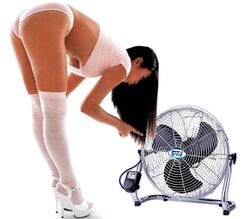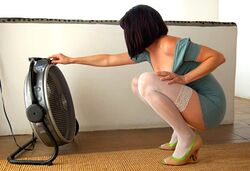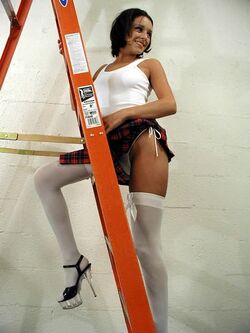Fan service
“Much of my inspiration for Lady Windermere's Fan came from the sterling work done by these young ladies...”
A fan is a useful device for keeping oneself cool in hot weather. However, whether your fan is electric or one of the more traditional "folded pieces of paper," it will occasionally require service. Fortunately, there are service stations in most major cities.
Prior to World War 2, fans were serviced primarily by overweight men with ill-fitting pants. However, when these men were drafted, the industry was taken over primarily by young women. Due to the suspicious number of fan serviceman deaths at the Battle of Iwo Jima, the industry has remained dominated by females to this day.
Fan servicewomen pride themselves on their competence, professionalism, and complete inability to find clothes that cover more than 40% of their skin.
Although fan service is a rewarding job, it also comes with certain challenges. In order to draw attention to the plight of these women, this article will focus largely on those challenges.
Challenges of fan service
Sore backs
Many people are unaware of the kind of strain that working in fan service can put on a young woman's back. Because fans tend to sit close to the ground, fan service requires a great deal of bending over.
Fan service workers deal with this problem in a variety of ways. It has been found that wearing short skirts is helpful, since slacks can quickly become worn and split apart after several weeks of constant bending. Similarly, shirts should provide as little coverage as possible, to minimize the discomfort associated with fabric chafing the breasts while servicing a fan.
Compounding the problem, women in the fan service industry tend to be better endowed than the general population, which shifts their center of gravity forward and can cause consistent strain on the anterior lumbar flexor. Sadly, breast reduction surgery is unavailable to most of these women, due to fan service union regulations that expressly prohibit it.
Occasionally, a fan servicewoman will work on her hands and knees to alleviate stress on the lower back; however, this can be problematic as well, as it places excess pressure on the knee joints.
Excessively warm work conditions
An occupational hazard of fan service is that servicewomen are often called to homes and offices that are far more warm than would usually be considered comfortable.
Now, one might ask, If it's so hot, why don't they just turn on a fan? But therein lies the conundrum: the reason the fan servicewoman is there in the first place is that the fan is broken.
Women in the fan service industry have developed a variety of ways to deal with this problem. Obviously, wearing minimal clothing is important. It is also important for servicewomen to stay adequately hydrated and drink plenty of water so that a thin, glistening sheen of perspiration can develop on her skin.
Finally, in larger fan service jobs requiring more than one servicegirl, it is a common ritual to take breaks every twenty minutes to have a playful garden hose fight on the lawn.
Despite these precautions, heatstroke remains a significant danger in the fan service industry. It is not entirely uncommon for a man to come home to find a fan servicewoman unconscious on the floor in a compromising position, her legs askew and skirt flipped up to reveal her exposed undergarments.
Working at Heights
In addition to the back strain caused by working on fans that sit close to the floor, the rising popularity of ceiling fans in recent years has forced fan servicewomen to deal with the challenges of working at heights.
This forces these women to work with highly specialized equipment, such as ladders and... well, they have to work with ladders. A large number of health and safety regulations exist in order to reduce the risk of injury through ladder accidents.
- All staff should be trained in the correct use of all equipment.
- Never carry heavy, bulky or awkward equipment or goods up a ladder.
- Firmly secure the ladder during any activities involving its use.
- Individuals should never reach out when on access equipment, as this can cause toppling or overbalancing.
- It is important to have a spotter at the bottom of a ladder.
- If a spotter is unavailable, the servicewoman should ask the customer to stand directly beneath her.
- Because falls can happen quickly and with little warning, the spotter or customer should look directly up at the servicewoman at all times.
- Ideally, the spotter or customer will hold his hands, slightly cupped, above his head, in order to catch the fan servicewoman should she lose her balance and fall.
Conclusion
Like coal mining and the manufacture of anti-theft ink cartridges, fan service is a thankless and difficult job, but one absolutely necessary to the continued function of Western society and also Japan.
Therefore, next time you see a fan servicewoman, perhaps you'll think of the trials and tribulations of her chosen career and respect her just a little more. Or, you'll mostly be hoping she falls off that ladder onto your eagerly cupped hands. But probably the former.
| Featured version: 12 July 2009 | |
| This article has been featured on the main page. — You can vote for or nominate your favourite articles at Uncyclopedia:VFH. | |




